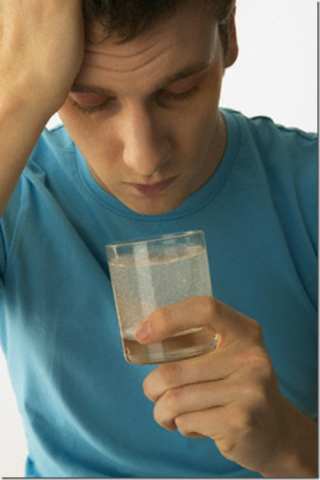 Alcohol withdrawal syndrome (abstinentia abstinence) is a syndrome of physical and/or mental disorders that develops in drinkers some time after stopping drinking alcohol or reducing the dose. Alcohol withdrawal syndrome is popularly called a hangover syndrome or a hangover.
Alcohol withdrawal syndrome (abstinentia abstinence) is a syndrome of physical and/or mental disorders that develops in drinkers some time after stopping drinking alcohol or reducing the dose. Alcohol withdrawal syndrome is popularly called a hangover syndrome or a hangover.Alcohol withdrawal syndrome is manifested by: increased heart rate and breathing, increased blood pressure or, conversely, increased temperature, chills, nausea, vomiting, diarrhea, weakness, headaches, loss of appetite, pain in the heart, pale complexion.
Neurological symptoms of alcohol withdrawal syndrome include the following: trembling of the fingers, eyelids, tongue, whole body and head, poor coordination of movements, decreased muscle tone.
The most severe alcohol withdrawal syndrome, developing after particularly long binges, may be accompanied by the occurrence of single or serial full-blown seizures with tongue biting and urination in the first three days after stopping alcohol intake.
Mental disorders. During alcohol withdrawal syndrome, night sleep is always disturbed, its duration is shortened, absolute insomnia may occur. Both delta sleep and paradoxical sleep suffer, their ratio is disturbed. Nightmares with a feeling of falling, falling, and the participation of animals often appear. The content of dreams can be scenes of chase, pursuit, attack.
At the height of a hangover, the attention span, its depth and stability are reduced, the ability to concentrate is weakened. The quality of mental activity is impaired more than the pace of its performance. The pace of mental activity is uneven, concentration and attention span disorders prevail, rather than asthenic manifestations. Low mood worsens the results of activity.
Short-term and long-term memory deteriorates, its volume decreases. Long-term memory suffers especially. Some drinkers have better preserved mechanical memory, while others have better preserved logical memory.
 The thinking of drinkers is characterized by a large number of alcohol associations that arise with extraordinary ease. This indicates the intensity of the craving for alcohol, which distorts the thoughts and feelings of drinkers, deforms the basic spiritual and social values ??and ideas. The level and productivity of thinking is reduced, judgments are full of cliches, creativity and humor are absent. The dynamics of thought processes are disrupted. Patients have difficulty understanding instructions, sometimes do not immediately grasp their meaning, appear stupid and uncomprehending. The purposefulness of thinking is periodically lost or weakened, which is expressed in absurd answers, random and superficial associations. The more severe the withdrawal syndrome, the more disorganized the thinking becomes. With a long history of alcoholism, a special slowness of thought processes, their inertia is noted.
The thinking of drinkers is characterized by a large number of alcohol associations that arise with extraordinary ease. This indicates the intensity of the craving for alcohol, which distorts the thoughts and feelings of drinkers, deforms the basic spiritual and social values ??and ideas. The level and productivity of thinking is reduced, judgments are full of cliches, creativity and humor are absent. The dynamics of thought processes are disrupted. Patients have difficulty understanding instructions, sometimes do not immediately grasp their meaning, appear stupid and uncomprehending. The purposefulness of thinking is periodically lost or weakened, which is expressed in absurd answers, random and superficial associations. The more severe the withdrawal syndrome, the more disorganized the thinking becomes. With a long history of alcoholism, a special slowness of thought processes, their inertia is noted.Affective disorders are represented by anxious-melancholy, dysphoric and apathetic subdepression. Anxiety is more pronounced before the age of 35, and depression after the age of 35. If a melancholy mood prevails, patients blame themselves for drinking and actions committed while intoxicated. The period of self-reproach lasts about as long as somatovegetative disorders exist. Low mood is often aggravated by various situational influences. The accompanying feeling of hopelessness can push patients to commit a suicide attempt. Most suicide attempts are demonstrative and blackmailing in nature and are most often the drinker's reaction to the refusal of relatives to give money for a hangover. A slow pace of work and laconic explanations of the task are characteristic. Images-pictures in the "pictogram" are evidence of depression: crosses, graves, tears. When dysphoria occurs, other drawings appear.ki: fists, knives, fights. This occurs in cases where melancholy is accompanied by irritability and anger. The dysphoric component can dominate in the presence of encephalopathy, especially residual changes after traumatic brain injury.
With a sharp increase in anxiety, sometimes there is a fear of death due to cardiac arrest, which is usually immediately reflected in the behavior of drinkers (calling a doctor to the house, demands to immediately give cardiovascular drugs). Sometimes, at the height of anxiety, there is a fear of death, combined with a feeling of lack of air. Alcohol withdrawal syndrome can not only include generalized anxiety disorder, but in some cases provoke the occurrence of panic attacks.
A severe hangover can be accompanied by the appearance in the evening or at night of isolated elementary deceptions of perception, hallucinations. With closed eyes, people, animals, strange creatures are seen. When falling asleep, there is a sensation of touch, sometimes it seems that someone is leaning on you and suffocating you. With abundant deceptions of perception, withdrawal syndrome is often classified as a pre-irritable state.
The desire for intoxication can increase sharply in a state of hangover. To satisfy it, patients are ready to sell things for next to nothing, run away from relatives, descending on ropes or tied sheets from an apartment window, commit illegal acts. In other cases, the desire for alcohol disappears and even an aversion to the smell and sight of alcohol appears.
The reverse development of alcohol withdrawal syndrome begins with an improvement in night sleep, the disappearance or reduction in the severity of affective disorders and somatovegetative disorders. Neurological symptoms (muscle tone disorders, truncal ataxia) last the longest.
 Taking small doses of alcohol (hangover) significantly changes the symptoms of alcohol withdrawal syndrome. This is primarily expressed in improved performance of simple tasks, a faster pace of work. This is mainly due to a decrease in anxiety and increased concentration. At the same time, hangover worsens short-term and long-term memory, does not increase the productivity of thinking, but helps to reduce the number of alcohol associations. Small doses of alcohol temporarily eliminate anxiety, but the low mood remains. Depressive self-esteem with self-reproach and regrets about drunkenness is revealed. After a short time, when the effect of alcohol ends, anxiety increases again, the desire for intoxication increases, criticism of alcohol abuse disappears. The temporary appearance of "criticism" should be regarded as an expression of depressive self-esteem; during the intensification of depression, psychological defense mechanisms are, as it were, blocked.
Taking small doses of alcohol (hangover) significantly changes the symptoms of alcohol withdrawal syndrome. This is primarily expressed in improved performance of simple tasks, a faster pace of work. This is mainly due to a decrease in anxiety and increased concentration. At the same time, hangover worsens short-term and long-term memory, does not increase the productivity of thinking, but helps to reduce the number of alcohol associations. Small doses of alcohol temporarily eliminate anxiety, but the low mood remains. Depressive self-esteem with self-reproach and regrets about drunkenness is revealed. After a short time, when the effect of alcohol ends, anxiety increases again, the desire for intoxication increases, criticism of alcohol abuse disappears. The temporary appearance of "criticism" should be regarded as an expression of depressive self-esteem; during the intensification of depression, psychological defense mechanisms are, as it were, blocked.A hangover cure allows us to differentiate between mental disorders that are a manifestation of alcohol withdrawal syndrome and disorders caused by alcoholic encephalopathy. Mental disorders that are an expression of alcohol withdrawal syndrome include anxiety, melancholy, exhaustion, weakening of concentration, narrowing of its volume, deterioration in the pace and quality of mental activity, disturbances in the dynamics of thought processes, and craving for alcohol. These disorders are temporarily eliminated by taking a small amount of alcohol. The manifestation of alcoholic encephalopathy are those disorders that intensify after drinking alcohol: deterioration of attention, memory loss, slowing of the rate of thought processes, their inertia, deterioration of the quality of mental activity, productivity of thinking.
After the disappearance of the manifestations of the hangover syndrome, the restoration of the quality of mental activity and its rate begins. The time frame for the restoration of normal mental functioning is determined not so much by the severity of the withdrawal syndrome as by the duration of the disease, i.e. the depth of encephalopathic disorders. Improvement of memory is noted. It often turns out that mechanical memory is impaired more than logical. This confirms the organic nature of the pathology, the number of alcohol associations decreases, the desire for intoxication weakens. If alcohol associations persist, this indicates the presence of a hidden or unconscious attraction to alcohol.
After the alcohol withdrawal syndrome has been relieved, it is possible to fully restore social and moral values ??distorted by the attraction to alcohol. In these cases, we can talk aboutalcohol-induced personality deformation as a temporary, transient morbid condition. The persistence of these distortions after the disappearance of the symptoms of alcohol withdrawal syndrome in combination with psychoorganic disorders indicates the presence of alcohol degradation. In these cases, such thinking disorders as thoroughness, a tendency to detail, an inability to distinguish between the main and the secondary, a decrease in the ability to abstract, insufficient productivity, and lack of criticality are detected. The self-esteem of patients with alcoholism depends on the characteristics of their character, the duration of the disease, the depth of personality changes, and during a hangover syndrome, mainly on the depth and structure of depression.
